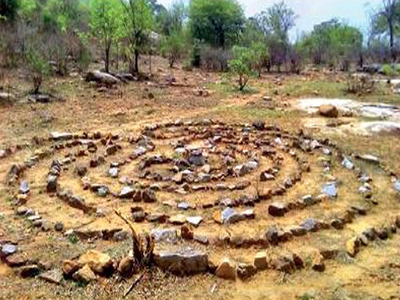
Chennai :
A rare circular labyrinth, about 2,500 years old, has been discovered at Kundhukottai, a remote village 55 km from Hosur in Krishnagiri district. It was after hearing from a shepherd about a strange circle of rocks in Kundhukottai, hero stone expert Sugavana Murugan and archaeological officer of the Krishnagiri Historical Research Centre S Paranthaman set off to the village a week ago. Since the village is situated close to the forest, they trekked more than six km to reach the site, crossing mounds of dry elephant dung on the way.
Soon after the discovery, the duo sent the details with pictures to Jeff Saward, a London-based expert in the field of labyrinths and mazes, for his opinion. After studying it in detail, Saward said it must be more than 2500 years old. With a complicated network of paths, labyrinths have been a fertility symbol associated with many cultures. They represent a unique pattern of consciousness and have been used as meditation tool since the Neolithic period.
“We discovered labyrinths in spiral and rectangular shapes, but this is the first time we have come across one in circle shape. Experts like Saward said it’s one of the oldest forms of labyrinths. We have to study the rocks in detail to find the exact age,” said Sugavana Murugan, who had discovered a rectangular shaped labyrinth in Kambainallur in Dharmapuri and a spiral one in Kundhani in Krishnagiri district in 2014 and 2016 respectively.
People used to worship labyrinths for various reasons. A labyrinth has seven paths and one has to come out through the right path. Even though it is difficult to find one’s way inside a labyrinth, it is believed that those who come out through the right path are blessed by the god. “People used to worship labyrinth to be blessed with a child, or to attain success in their pursuits and for long life for their cattle,” said Murugan.
After verifying the photographs, T Satyamurthy, former superintending archaeologist of the Archaeological Survey of India (ASI), said the labyrinth in circle shape was an interesting discovery. “It’s a promising one. But we have to conduct further excavation on the site to find the age and the actual role played by this labyrinth in the life of people those days,” he said.
The labyrinths and mazes, according to Saward, have been found to be in existence since the Neolithic period. “Maze is a multi-curved category where we have multiple pathways to reach our goal, whereas in labyrinths there is only one pathway which leads inexorably to the goal from the point of entry,“ said Saward, who is editor of `Caerdroia’, the journal of mazes and labyrinths. EOM
source: http://www.timesofindia.indiatimes.com / The Times of India / News> City News> Chennai News / M.T. Saju / TNN / April 10th, 2018